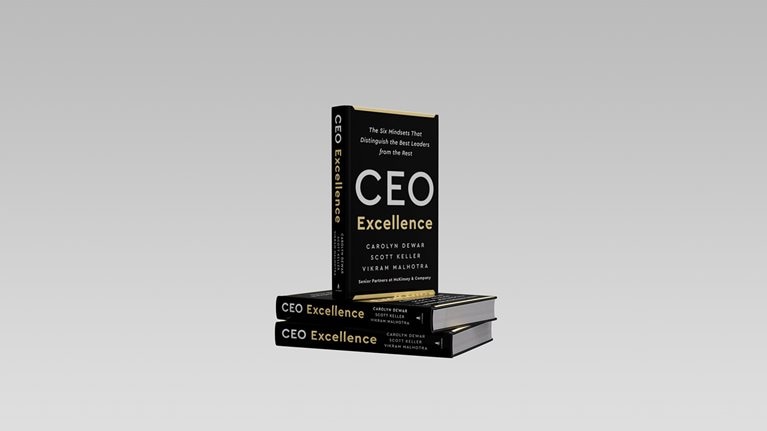Last year, policy makers, economists, and financial-market participants fiercely debated the higher inflation then under way. Was it a transitory problem, caused by dislocations from the COVID-19 pandemic that would inevitably fade, or was it a more fundamental and potentially permanent shift? CEOs told us that they viewed this debate as detached from the business environment in which they operated. For them, higher inflation was already “permanent enough” to start asking whether a fundamental shift in the way they led and managed their organizations was required. We agreed.
In the first months of 2022, it became increasingly apparent that this year and next—and possibly longer—inflation rates well above the approximately 2.0 percent that planners have come to expect (and central banks have targeted) will prevail. The consumer price index rose by 8.5 percent from March 2021 to March 2022 in the United States, a 40-year high, 7.5 percent in the eurozone, and 7 percent in the United Kingdom. Some 60 percent of advanced economies grapple with year-on-year inflation above 5 percent.1 Russia’s invasion of Ukraine, and the resulting disruptions to the energy, agriculture, and minerals markets, have made it likely that inflation will be higher and more persistent than even revised expectations suggest (Exhibit 1).

Following a well-established inflation management playbook, central banks worldwide are raising interest rates to temper demand and regularly issuing statements to try and keep in check consumer and business expectations of future inflation. This task is becoming more urgent, as markets now expect inflation over the next five years in the United States, the United Kingdom, and Germany to be 1.5 to 2.0 percent higher than their 2010–2019 average.
Even if the central bankers succeed, progress will take time. Two more years of higher inflation are a long time for business leaders. The ad hoc crisis response that many have been following thus far is reaching the end of its usefulness.
How can CEOs guide their management teams, employees, boards, and a wide range of external stakeholders through this period? For starters, it’s important to recognize that the CEO’s focus cannot be limited to inflation’s implications for profitability. Operating in today’s uncertain environment, with a much wider range of stakeholders, means that leaders must think about performance in much broader terms. The rapid decisions CEOs had to make in recent weeks about operations in Russia is only the latest example of these expanded considerations. CEOs must lead with the complete business cycle and their complete slate of stakeholders in mind. External relations professionals can help stakeholder management, but there are many conversations and decisions where only the CEO can lead.
Like central bankers, CEOs need an inflation management playbook. They can start scripting it by asking themselves and the senior leaders of key operational areas the following questions:
- Where will customers see value in this new environment? How can we design products, services, and experiences to deliver this value?
- What is the fastest way to stabilize and redesign stretched and, in some cases, broken supply chains? What capabilities will I need to increase my company’s resilience and control costs?
- What direction should I give to help procurement leaders create value?
- How is the new talent landscape affecting compensation, benefits, and workplace norms? What can I do to attract and retain employees in today’s shifting labor market?
- How should I pursue repricing in an inflationary environment? How can I form a through-cycle and strategic mindset for my customer relationships?
- How can I set priorities and organize to direct all this activity?
The CEO is an organization’s ultimate integrator. Our research into the behaviors and mindsets of excellent CEOs shows the pivotal role that chief executives play in setting a clear direction, aligning the organization, managing stakeholders, and serving as “motivator in chief.” The best CEOs act boldly, of course, but also operate from core mindsets that often belie the classic image of the hard-charging executive: they approach important decisions by listening first, treat “soft” culture topics as a hard material advantage, empower employees, and ask questions constantly.
In this article, we draw upon our work with hundreds of companies and tap into deep research to construct an inflation playbook that should help CEOs no matter what direction inflation takes. Remember, during the height of the COVID-19 pandemic, companies demonstrated their ability to reinvent themselves more quickly and thoroughly than they had once thought possible. They can do that again.
Leaders will motivate their organizations to raise the profile of design to a C-suite topic.
Redesign product and service offerings for value and availability
CEOs know that design choices for products and services are critical for responding to the volatility of commodities, the scarcity of components, and higher production and servicing costs—all while maintaining the core functionality customers require. Consider these examples of agile approaches that best-practice operators across sectors have used:
- Rapidly redesign products and services to adjust to new realities. One industrial-technology company redeployed more than 50 percent of a single unit’s engineering capacity to rapidly redesign products so that they used semiconductors available in the market. Automotive manufacturers facing semiconductor shortages “de-featured” products to maintain production and sales in the face of these shortages.
- Challenge specification orthodoxies. Faced with historically high costs for lumber and other inputs, a manufacturer redesigned many products to specifications that overseas manufacturers could reliably meet. In this way, it reduced its dependence on high-cost regional suppliers—and dramatically simplified its product portfolio.
- Redesign the way you provide service. With transportation costs increasing rapidly, so is the value of loading trucks and containers efficiently. A manufacturer used its engineering expertise and tailored digital tools to completely rethink packaging and the loading of packages. It reduced costs significantly as a result of reduced freight demand.
- Promote near-substitutes. Consumer-packaged-goods companies identify product substitutes—often private-label equivalents that can be sold at lower costs than branded products. These substitutes maximize margins and increase the value to customers.
Mobilizing cross-functional expertise to quickly identify and implement alternative solutions to product and specification challenges will be the key for companies that seek to mitigate scarcity and the impact of inflation. In many cases, only the CEO can break down the barriers to innovation and reward the organization for taking risks counter to typical incentives. Leading their organizations’ reimagined design is an opportunity for CEOs to nimbly implement short-term tactics to cope with inflation and capture the longer-term opportunity to forge stronger relationships with customers.
It may be that the CEO’s most difficult task will be convincing investors to accept resiliency as the new table stakes.
Clean-sheet and build digital, integrated, transparent, and agile supply chains
Well before the invasion of Ukraine in February 2022, new tariff regimes and increasing shipping and trucking rates that emerged during the pandemic had called into question the old-school thinking that made cost optimization the primary goal of managing supply chains.
In 2021, our research and discussions with hundreds of supply chain leaders found that an overwhelming majority had problems in their global manufacturing and supply footprints. Global shipping costs have risen significantly (Exhibit 2). In response, many companies moved to increase inventories and find new sources for raw materials. But far fewer have successfully tackled such difficult tasks as reducing the number of SKUs and diversifying their manufacturing base. The global response to Russia’s invasion of Ukraine means that supply chains are further strained: air carriers are using alternate, often less-direct routes because of airspace closures, shipping companies are suspending activities near the conflict zone, and many multinationals are scaling down or stopping operations in Russia.

The logistics of carriers and gnarly supply chain topics had once been the exclusive domain of backroom spreadsheet managers. Today they are standard topics around C-suite and boardroom conference tables. We see several critical issues that CEOs should push their teams to pursue aggressively.
Make your entire supply chain visible
Just under half of the companies in our survey say they understand the location of their tier-one suppliers and the key risks those suppliers face. Remarkably, only 2 percent make the same claim about suppliers in the third tier and beyond. That matters because many of today’s most pressing supply shortages, such as semiconductors, happen in these deeper supply chain tiers and can be solved only by understanding industry dynamics at the “tier-n” level.
CEOs must push their organizations to collect the data required to create this n-tier mapping and prioritize suppliers by the importance to their business. Who should the CEO be calling on personally to ensure they cement critical relationships?
Identify and manage potential supply chain risks
Depending on a company’s sector and needs, CEOs must factor in a range of risks, including those involving finance, regulation, reputation, and data security. Operational-risk management is particularly important: examine the vulnerabilities inherent in the concentration of suppliers in the same area, the visibility of operations and processes, labor, manufacturing, and delivery. Do you have a transparent view of the parts of the value chain exposed to internal or external disruptions? Are you confident that controls are in place and options are available to minimize the impact of these risks?
Make seamless end-to-end planning a CEO priority
End-to-end planning involves several things. On the supply and demand side, companies must plan for longer lead times and earlier ordering. The financial implications of increased transportation, energy, and materials costs on working capital must be understood. The reorder points and stock of critical materials in inventory have to be reviewed. Production programs must be reprioritized in the event of foreseeable shortages.
CEOs recognize that all of this entails investment for which there needs to be a return. Will customers pay a premium to ensure the availability of goods? Will suppliers accept cost sharing to lower the risk of disruption in demand for their products while balancing these costs by raising their own productivity? The CEO’s most difficult task may be persuading investors to accept resiliency as the new table stakes and to change their view of expected risk-adjusted returns. The good news is that digitalization will likely play an important role in answering these questions, and digital efforts often pay back their costs in 12 months.
CEOs that empower their procurement organizations can raise the bar on value-creating contributions.
Transform procurement to create value, not just cut costs
Over the last two years, critical supplies have been scarce or even unattainable at any cost within needed lead times. Prices for nearly all supplies have been rising in tandem globally, and labor market disruptions have affected nearly everyone. Procurement leaders have told us repeatedly that this is the toughest market environment in at least 20 or 30 years. New and changing circumstances have upended decades of procurement practices and management capabilities honed to globalization and just-in-time deliveries.
CEOs are beginning to recognize that purchasing leaders can be full-fledged strategic partners by expanding their focus from the cost of goods sold (COGS) to creating value and helping the enterprise succeed. In response to these needs, procurement leaders have implemented, in weeks, actions that previously would have taken months and years. Some examples follow:
- Expanding focus to “everything is in play.” In response to the scarcity of contracted labor and higher prices from suppliers, the supply chain team of one electric utility partnered with procurement to redesign end-to-end engineering and construction workflows. This change tightened governance, maximized demand, simplified requirements, changed how work was allocated, and put in place new contractor management processes. These moves all helped to ease inflationary pressures.
- Basing contracts on the current reality. An industrial manufacturer faced across-the-board cost increases from suppliers. In response, it documented every such rise in fine-grained detail to better understand the exact cost drivers of each product or service, to improve internal cost models, and to build better contracts indexed to the right commodities and input costs.
- Rethinking logistics and geographic sources. Facing challenges to product deliveries from Asia, one electronics manufacturer increased sourcing of production in the United States and Mexico. Another purchased its own fleet of aircraft to deliver products from Asia to end-user markets.
- Considering vertical integration. Retailers are making acquisitions to control value chains for key products. Automotive manufacturers are contracting directly with foundries to reserve capacity. Energy producers and utilities are exploring investments to onshore the manufacture of key production components for renewable energy.
- Investing in technology and process automation. Taking a page from law firms, a mining company shifted its technical-services contractors to 15-minute increments for billing and gave them the technology needed to track their time. By minimizing the rounding up of hours, the company saved 5 to 8 percent of costs across contractor trades.
CEOs can empower procurement leaders who are uniquely positioned to integrate a deep understanding of the business with supply market insights. These leaders can play a more central coordinating role across operations, finance, commercial, and other functions and thus help the broader enterprise become more efficient and resilient.
A CEO can take a lead role in playing back the feedback the organization is hearing.
Adjust to the new talent game
Employee wages and benefits are one of business’s biggest costs. Wage increases put pressure on a company to maintain margins potentially by increasing prices. At the same time, wages and benefits are one of the most important levers employers have to attract and retain employees and help them ensure that they can provide for themselves and their families in a higher-inflation environment. The progression of wages and benefits are top of mind for CEOs.
Private-sector wages in the United States have increased at a 6.6 percent annualized rate since December 2019. That is more than twice the rate of the two years before the COVID-19 pandemic. Wage increases reached 6.4 percent in the United Kingdom over the same period, while furlough and other labor market policies that were followed during the pandemic resulted in less disruption and kept eurozone wage inflation thus far in check. Differing labor market policies and conditions have led to a broad dispersion in wage growth around the globe (Exhibit 3).

In a tight labor market, the departure and mobility of workers creates wage and inflation pressures as companies compete for workers.2 Understanding why employees are leaving their jobs is the first move for CEOs trying to play the new talent game. Workers we surveyed across seven countries believe that the cost of switching jobs has gone down significantly and that there is much less stigma attached to gaps in a résumé. People who voluntarily left their jobs without having another in hand cited factors such as uncaring leaders, unsustainable expectations of work performance, and a lack of career advancement. In the current labor market, employees believe they can find work whenever they are ready for it.
To rebuild relationships and retain current employees while attracting new ones, CEOs must guide their companies to take a new approach to talent, focusing on the following core principles.
Don’t believe it’s enough to rethink compensation and benefits
Market compensation and benefits packages are just the ante. To attract and retain disillusioned employees, companies can’t just write one big check after another and expect that to be successful. Leaders must simultaneously pay constant attention to both compensation and cultural factors.
There is no one right way to reimagine compensation; some trial and error will be involved. With pay transparency at an all-time high, companies run the risk that a salary misstep could prompt even more departures. Think about how your company can help employees find the sense of purpose and belonging that can make it more attractive to join and, ideally, more attractive to stay. Subsidizing services such as childcare—in the office or in a hybrid setting—could help employees with some of the competing demands of work and home.
Make your work model ‘sticky’
How can CEOs help their management teams shift focus to anticipating and addressing the concerns of employees by fostering a sense of inclusion, psychological safety, and community? Exit interviews won’t go away, but why not add “stay interviews” that ask people how they’re doing, what they need, and what aspirations they may have for other roles?
Frontline managers may be encouraged to try scheduling, staffing, and hiring innovations. Some companies have tried offering “well-being” bonuses to employees or providing them with extra days off for professional development or mental-health breaks. One theme park and entertainment company offered to pay 100 percent of the tuition costs for employees seeking higher education.3
Find nontraditional and ‘latent’ workers
In the United States alone, more than 80 million people already in the labor force (either working or looking for work) don’t have four-year college degrees but have or can develop the skills that employers need to get the job done. These include students, part-time or contract (or gig) workers, people in one-person start-ups, and people who are not actively seeking a traditional job at a traditional employer but might want jobs under the right conditions. And this could be the moment to bring back the record number of women who left the workforce during the pandemic. To reach these women and men, companies must actively challenge the barriers to entry, rethink role requirements, and change the process of searching for employees.
A CEO can signal the importance of these new possibilities by taking a lead role in reporting the feedback the organization is hearing, transparently setting the goals and aspirations for change, and directly participating in important hiring and retention activities with employees.
Forging new pricing relationships with customers will test CEOs in their role as the “ultimate integrator.”
Set prices to strengthen customer relationships
It’s a fundamental question in inflationary environments: What to do about pricing? As costs rise, repricing to sustain margins is nobody’s idea of a good time; it is typically unpleasant for companies and worse for customers. But CEOs have a chance to reframe customer relationships strategically by viewing repricing as an opportunity to forge deeper relationships with customers. The CEO can direct these conversations toward sharing common challenges and helping management to meet both their anti-inflation goals and those of their peers.
CEOs can ask a number of questions to help surface opportunities for strategic repricing:
How can we adjust discounting and promotions and maximize nonprice levers? Companies that consistently address total customer and product profitability are likely to weather inflationary cycles better than those that focus solely on cost changes. A manufacturing company facing a surge in demand for high-cost, low-volume products, for example, lengthened its lead times, especially for custom products with lower margins. Sales teams were trained to explain the new service levels and encourage customers to opt for more standardized alternatives. The result was an overall productivity increase that maintained margins without price increases.
Can analytics help us personalize more effectively? Best-in-class companies typically ground their price increase recommendations in analytics. These organizations examine their customers’ end-to-end profitability, willingness to pay relative to a comparable peer set, and the margin performance (at a product and service level) expected from price changes. Retailers have long used personalization tools to tailor promotions; B2B companies now have dynamic segmentation tools that allow them to do the same.
Can we communicate our value more effectively? Raising prices in response to inflation is seldom a one-and-done move; it is full of unintended and unexpected consequences. Companies that manage price increases well often have a council of cross-functional decision makers who can respond quickly to feedback from customers and markets.
Taking advantage of the opportunity to forge new pricing relationships with customers in a higher-inflation environment will test many CEOs in their role as the ultimate integrator of the enterprise. Keep inflation high on the company’s agenda with regular communication and role modeling, particularly with the leadership of sales and the frontline sales teams. Keep one eye on short-term margins and price fluctuations and the other on strengthening ties with customers and communicating value more effectively.
Achieving a focus based more on strategic action and less on firefighting requires steps that only the CEO can take.
An inflation program management office
Managing the implications of inflation across a broad operational landscape calls for a cross-functional, disciplined, and agile response. During the pandemic, many CEOs instituted response nerve centers, flexible structures with enterprise-wide authority to coordinate the response to and return from the pandemic and to test approaches to recovery. Similarly, some companies erected inflation nerve centers to manage the potential downside of inflationary pressures by breaking down silos, enhancing transparency between functions, and concentrating on the crucial leadership skills and organizational capabilities required to get ahead of events rather than react to them.
Failing to coordinate across functions can have expensive consequences. A company that relied on monthly meetings among supply chain, operations, and procurement teams needed more than 30 days to decide on its action plan to counter inflation. Then, an additional 30 days were required to execute. During those two months, raw-material prices increased by almost 50 percent. Monthly business reviews or quarterly supplier workshops are not enough to handle fast-moving price changes, fluid negotiations with suppliers and customers, and the internal adjustments such pressures require.
We believe that CEOs should opt for a more proactive, durable management office for their inflation program. Such a center can benefit the entire enterprise by improving the pace and quality of its decision making and helping it to focus more on strategic action and less on firefighting. Achieving this goal requires a few important steps that only the CEO can take:
- setting a clear mandate and goals, communicated to the entire organization, for the inflation management office
- empowering the CFO or another direct report to coordinate these activities and carry out the CEO mandate
- selecting a team of functional leaders (for instance, HR, commercial, supply chain, operations, engineering, and finance) who have a bias for action and may not be department heads
- making it clear that decisions must often be taken in the face of significant uncertainty and that mistakes will undoubtedly be made
- insisting on a systematic, fact-based approach to transparently track execution, diagnose wins and losses, correct course, and learn
A nimble, well-informed decision process can keep up with rapid change by making it clear when certain thresholds are met and generating responses to problems. Many companies will find that they have most of what’s needed to create such a center. These resources can be organized to form an agile capability in a few weeks rather than months or years. With the inflation program management office up and running, CEOs can be freed from the day-to-day details of the anti-inflation effort to focus instead on the issues they are uniquely positioned to address, from higher-level board and stakeholder discussions to shifting their strategies to best capitalize on the current environment.
Someone, somewhere, pays for every uptick in inflation. Customers pay at the end of the supply chain in higher prices. Suppliers pay when their customers derisk production by seeking alternatives to their products. Shareholders pay higher costs as the ante for competing and maintaining a viable business. With the right playbook as a guide, the best CEOs will successfully manage the impact of the current higher-inflation environment and establish a new level of organizational resilience no matter where prices move next.






